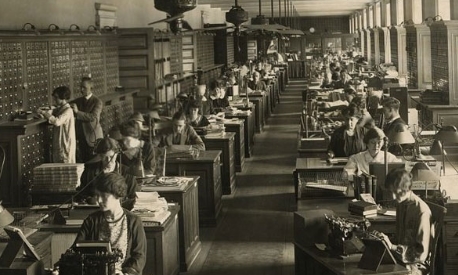
For decades, billions of men and women around the world woke up, ate breakfast, and went to work.
There, they sat in redundant meetings hour after hour, opened countless file folders and filled out dozens of interdepartmental mail forms.
At the end of the day, they went home, ate dinner, slept, and started the process all over the next morning.
Relatively little has changed in the sleeping and eating department, but the same cannot be said for the office. As technology has rapidly evolved over the last century - the workload, the job titles, and even the core job functions of a professional today are unrecognizable to an early or even mid-1900's counterpart. Let’s take a look at some of the ways technology has changed the way people work.
Sometimes, it’s hard to believe that there was a time before email. Prior to the introduction of email, communication was beholden to physical forms like the telegram, written letter, or faxes.
Email opened a world of instantaneous deliverability, which concurrently streamlined communication and made it faster to disseminate important information to all of the involved parties.
It also helped to eliminate the need for pesky physical filing cabinets. Instead of digging through an endless sea of manila envelopes or hanging folders, a quick email search can now turn up the intended file, along with a paper trail of where it came from and where it was going next. The unlimited potential of email in business can’t be denied. A Radicati report estimates that by the end of 2019, over one-third of the world’s population will be using email.
Video Conferencing
Traditionally, “work” was defined as going into an office building and putting in your required hours, 5 days a week (at least). And meetings were held in a boardroom, in front of a whiteboard, with everyone frantically taking notes to stay on the same page.
A slightly more evolved version became the conference call, with everyone huddled around a central speaker to make sure that everyone could be heard and understood.
Now, this same principle has further advanced to include video conferencing. To point out the obvious benefit, video is visual. You might be wondering, why is this important? Accountability. On a conference call, you don’t know if they’re staring at the ceiling or scrolling through their Facebook feed for the tenth time that day. On a video conference, they must provide their full and undivided attention, as if the meeting was taking place with everyone in the same room.
Document Collaboration
More importantly, new technological advancements continue to increase productivity and efficiency.
Where it used to be commonplace to have your team collaborate on a document, passing around a paper version (that could easily get lost) and scribbling notes in obnoxious red ink, document collaboration tools have eliminated these inefficiencies.
These tools allow you and your team to work on the same file while tracking notes and changes. Some even implement a social media aspect, enabling you to leave comments in a thread, similar to Facebook. Your team is held responsible for any questions and notes they have on the document, eliminating the “he said, she said” arguments that can hold up indefinitely even the simplest of files.
There are so many more ways that technology has improved the workplace and we will explore a few more of those next time.
In the meantime, what changes have you seen in the workplace in your lifetime?
Do you remember a simpler time before technology?
Leave a comment below and let us know.


BobbuBrowne
Hello! Cool post, amazing!!!